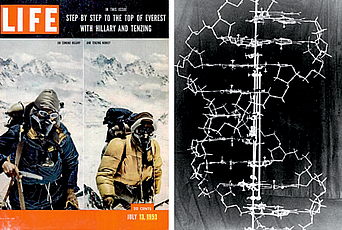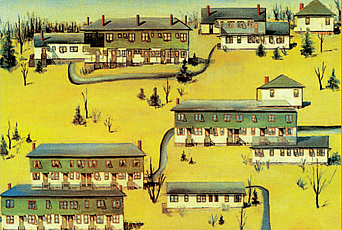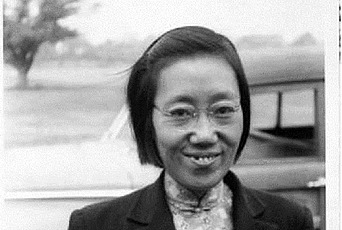IAS Visit Inspires Creation of Institute of Mathematical Sciences

My father Alladi Ramakrishnan (1923–2008), who made significant contributions to stochastic processes, elementary particle physics, matrix algebra, and the special theory of relativity, passed away at my home in Gainesville, Florida, last June, at the age of eighty-four. Inspired by his visit to the Institute for Advanced Study, where he was a Member in 1957–58, he later founded and directed the Institute of Mathematical Sciences (MATSCIENCE), in Madras, India.
Initially attracted to law—my paternal grandfather Sir Alladi Krishnaswami Iyer was a prominent Indian lawyer who helped draft the Constitution of India—my father decided to pursue a career in science after he heard Homi Bhabha give a lecture on Meson Theory at the Presidency College in Madras in 1943.
In 1947, my father joined Bhabha’s fledgling Tata Institute of Fundamental Research in Bombay. Bhabha introduced my father to cascade theory and the problem of cosmic radiation, the study of which required the probabilistic analysis of the distribution of a discrete number of particles in continuous energy space. In attacking this problem, my father introduced a new technique, which he called the method of product densities. In 1949, my father left the Tata Institute and sailed to England to complete his Ph.D. under Professor M. S. Bartlett of the University of Manchester. My father’s thesis work on product densities, which extended the earlier work of D. G. Kendall, appeared in the Proceedings of the Cambridge Philosophical Society, and is considered among his major contributions.
After his Ph.D., my father returned to India and joined the University of Madras first as a Reader, then as Professor of Physics. During the fifties, he developed the theory of product densities and its applications in collaboration with his students. He came into contact with the astrophysicist Subramanyam Chandrasekhar, who provided the Astrophysical Journal with eight of my father’s papers, some of which dealt with the fluctuation of brightness of the Milky Way. In 1955, my father was elected a Fellow of the Indian Academy of Sciences with the backing of Nobel Laureate Sir C. V. Raman.
The visit was a turning point in his career. At the Institute my father had the opportunity to listen to the lectures of leading physicists of his generation.
In 1956, at a high-energy physics conference at the University of Rochester, my father met J. Robert Oppenheimer, then Director of the Institute. Oppenheimer inquired about my father’s plans for the future, and my father replied that he would like to visit the Institute. Within a few months, my father received an invitation to come for the academic year 1957–58.
The visit was a turning point in his career. At the Institute my father had the opportunity to listen to the lectures of leading physicists of his generation. T. D. Lee and C. N. Yang had just completed their famous work on nonconservation of parity in weak interactions. They were in residence at the Institute that year and everyone was excited about the possibility of a Nobel Prize, which they received shortly thereafter. In those eight months, my father heard over one hundred seminars—Bengt Strömgren on astrophysics, Marvin Goldberger on dispersion theory, Rudolf Haag on scattering, Abraham Pais and Sam Treiman on weak interactions. Oppenheimer was an active participant in the seminars. My father wrote in his diary, “Oppenheimer’s very presence stimulated creative thought and invited impartial criticism.” As a result of these lectures, my father shifted his research to elementary particle physics in the next decade.
After his year at the Institute, my father returned to India filled with a desire to induct talented students into theoretical physics and expose them to the latest advances in the field. Not satisfied with the curriculum at the University of Madras, he conducted theoretical physics seminars at our family home between 1958–61. Eager students gathered at the seminar and he invited well-known scientists from abroad to address them. My mother graciously hosted the visitors and the students.

When Nobel Laureate Niels Bohr, a former Member of the Institute, came to India in 1960 as the guest of Prime Minister Jawaharlal Nehru, he lectured in my father’s seminar. Upon his return to Delhi, Bohr was asked for his opinion about science in India. He said that two things impressed him the most—the massive Tata Institute in Bombay, and the small group of students trained by my father in Madras. Bohr’s statement, which was reported in newspapers like the Hindu, prompted Nehru to meet with my father and his students. At their meeting, Nehru asked my father what he wanted. My father asked for an institute for advanced fundamental research like the Institute for Advanced Study in Princeton. MATSCIENCE was created on January 3, 1962.
My father served as the Director of MATSCIENCE for twenty-one years until his retirement in 1983. During his tenure, hundreds of important mathematicians and physicists visited MATSCIENCE. After I moved to Florida permanently in 1987, he and my mother made extended annual visits to Gainesville. Even in his retirement, his spirit of inquiry remained unabated, and he published papers on the special theory of relativity. I close with a dictum that he had inscribed on the walls of MATSCIENCE:
The pursuit of science is at its best
when it is a part of a way of life.


